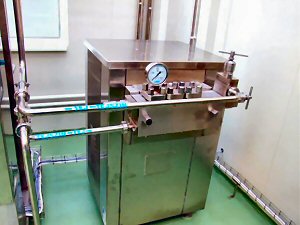Homogenization: A Closer Look
Raw milk, as it comes from the cow, is an
emulsion- a mixture of milk-fat globules, various solids and water. Over time, the fat globules separate out and rise to the surface as a layer of cream, leaving what is essentially skim milk, down below.

In the years before today's processed dairy products, some people found this to be an inconvenience because it meant the milk had to be agitated often to keep the cream mixed in.
Others used the separation as a way of telling whether they were getting a decent amount of fat in the milk. Apparently, some unscrupulous dairymen would skim off some of the fat to make higher profit margin butter or ice cream, leaving the milk drinker short a few percent.
Enter inventor Auguste Gaulin, a Frenchman who, like Pasteur before him, had a hand in further changing the physical and chemical properties of milk. Gaulin's brilliant invention, an emulsifying or 'homogenizing' machine, patented in 1899, (above, a modern version) broke milk's fat globules into a smaller, more uniform size that resisted separation and rising. Since then, over a hundred patents have been granted to other devices aiming for smaller and smaller particle size while using less and less energy.
In spite of the successful machinery, however, consumers weren't easily convinced that homogenization was such a good idea. By some accounts, homogenized milk wasn't sold successfully until about 1919 when the people of Torrington, Connecticut bought enough of it to get noticed. Many skeptics held out for years longer, though, prompting one Michigan dairy to pull out all the stops to convince milk drinkers of homogenized milk's easier digestibility.
Sales persons were sent out with samples of partially digested milk curds, harvested from the stomachs of other employees ("How?," one is inclined to ask), to convince wary housewives of homogenized milk's benign properties. Apparently the campaign was successful. "Yes, ma'am, it most certainly is easier on your stomach. Why, just look at these samples of vomit I happen to have with me today..." Intriguing.
Homogenization today is usually a two step process. The first stage, similar to Gaulin's early device, pushes milk through small, tapered tubes or pores. As the diameter shrinks and the flow of milk remains constant, pressure builds up and fat globules break apart in the turbulence.
The higher the pressure, the smaller the particles. How much pressure? Typically 2,000-3,000 pounds per square inch (psi), although some super homogenizers work at over 1000 times atmospheric pressure- 14,500psi and higher!
You can jam milk through pretty small holes with force like that. Before homogenization, fat globules range in size from 1-10 microns (a micron = ~0.00004 inch). After, the size range is reduced to 0.2-2 microns.
As the much smaller fat globules begin to reassemble, they include fragments of whey and casein in their walls. Some are completely surrounded by a layer of protein. The tendency is for these new, chemically altered globules to clump together. Stage two of the homogenization process breaks up this unwanted assembly and makes sure everything stays in solution.
Some researchers believe that these protein-heavy fat globules can potentially increase homogenized milk's ability to cause allergic reactions. Numerous studies confirm this, at least with rodents as test subjects. Other known effects on milk quality include increased viscosity (the milk is thickened in consistency) whiter appearance, lowered heat stability, increased sensitivity to light-triggered oxidation and less pronounced milk flavor.
Homogenization usually follows pasteurization because the enzyme lipase, if not first heat deactivated, can begin digesting the ruptured fat globules, leading to rancidity in the milk. That's becoming less of a problem, however, because at the incredibly high pressures to which milk is now being subjected, very high heat is generated, resulting in what is, effectively, a second pasteurization process.
Maybe you need a proposal for your research paper on homogenization? Hire academic writers and buy research proposal at CustomWritings.com online.